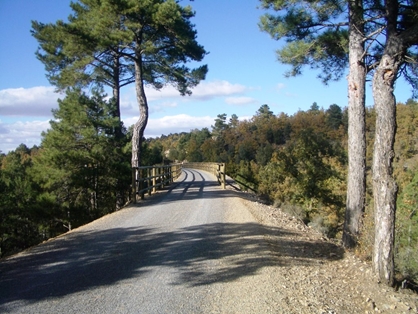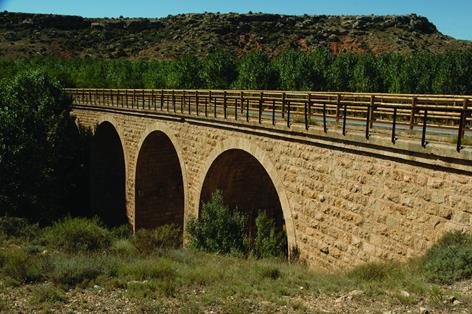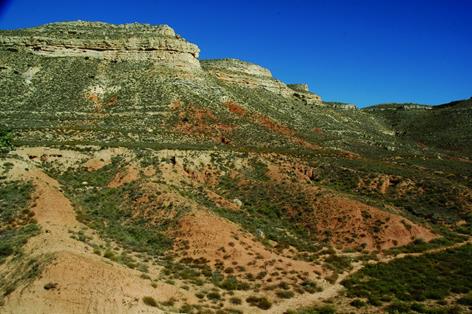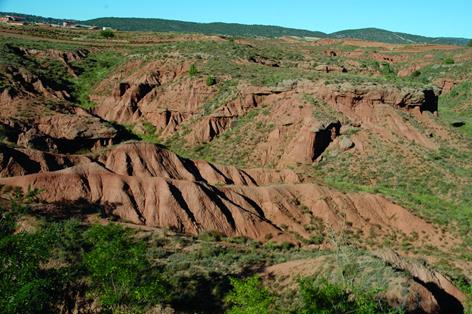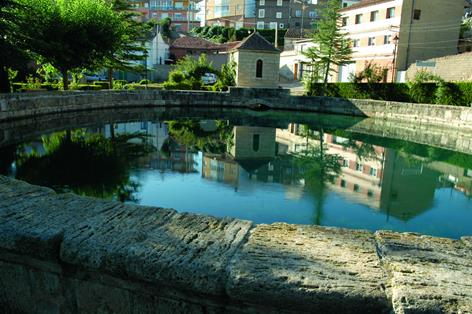- Home
- Rural Development
- Nature Trails
- Nature Trails
- Northeast Sector
- Ojos Negros
Ojos Negros Nature Trail
Description

Following the steps of Rodrigo Díaz de Vivar, "el Cid"
The open banks of the wide valley of the River Jiloca are made of sandstone, clay and limestone slabs, and are home to a biodiversity that is proper to a steppe habitat, which is why it will not be difficult for trail users to come across esparto fields, stone curlews, larks and little bustards.
The beginning of this Nature Trail towards the Port of Escandón is located at the old train station of Santa Eulalia, on the A-1511 highway in the direction of Pozondón.
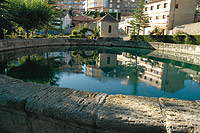
The route begins by crossing a steppe formed of plots used to grow cereal crops across which rural paths interlink, avoiding small gullies and the riverbeds of seasonal streams. The track reaches a village called Las Granjas and then it passes by some isolated country houses, like Lanzuelas, Boleas or Serrano, next to an irrigation canal that waters the cornfields and poplar groves of Cella. The Trail immediately crosses a tarmacked cattle track and begins a long stretch shared with vehicles, although traffic is few and far between as it is only used by farmers.
On returning to the route, the Nature Trail crossing continues among afforested poplar plantations that reveal where the natural bed of the almost dry river used to go. This stretch still preserves the remains of the bridges of the old farm pathways over the Ojos Negros mining railway line which the Nature Trail runs alongside. At the end of a stretch of irrigated land, on the same level, the route crosses the road that enters Cella via a new roundabout, and passes by old farrowing accommodation that is preserved next to an industrial fence.
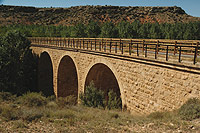
The town of Cella, set on a hill, is two kilometres from the route, but it is a good idea to take a detour and go there so you can walk around its narrow mediaeval alleyways and the Town Hall Square, as El Cid did, and visit the source of the River Jiloca, which is located in a large artesian well in the town. This well is one of the largest in Europe and was restored by the Templars in the 12th century.
After Cella station the Trail heads towards Caudé through non-irrigated land, gradually approaching the modern Mudéjar (A-23) highway and the slopes of the valley. And underpass first, and an over pass next are used to overcome two asphalt roads that runs both sides of Teruel airport. It finally crosses under the N-234 highway, and then over the railway track via a new metal walkway which, on being overhead, offers excellent views.
The small Teruel district of Caudé lies next to the route and, from the station, you can go down to the fountain located next to the church to fill up your water bottles.
The Nature Trail runs along a flat section until it crosses the A-23 highway in the direction of Concud, to then descend gently towards the fertile lowland of the River Alfambra, and then continue along the Cerrillo de Casa Roya as far as Teruel station, located five kilometres away from the town. A few meters far from the station, the Trail connects with River Alfambra river path.
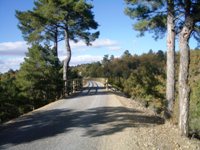
After visiting the capital, which is a must-see and a World Heritage Site, the route crosses an area of extremely beautiful gullies, at the Puntal de la Hoya Blanca, and gradually climbs upwards to pass under the viaduct of the A-226 and A-23 highways. You will cross under the road several times further ahead. It is then that forest land appears for the first time, the pine groves of La Hoya de Teruel. Successive cuttings and embankments maintain a gentle slope that ascends as far as the viaduct over the Rambla de Río Seco and crosses again the A-23 highway, this time via an overpass.
Little by little, the scrubland gives way to thick pine groves filled with holm oaks (Quercus ilex), junipers (Juniperus communis and J. oxycedrus, J. thurifera and J. phoenicea). After a viaduct, you reach Valdecebro station, in the middle of a pine grove that prevents erosion problems. After the Trail approaches the highway, the substratum changes to limestone and thicker woods appear. Large cuttings, two tunnels and four more viaducts cross the juniper thickets and pine groves of the Puerto del Escandón, where an information panel indicate the end of the Nature Trail and the Ojos Negros Green Track, although the route, equipped and well-signposted, can be followed as far as Sagunto.
Sites of interest
Map
Puntos de Interés
Geología
Profile
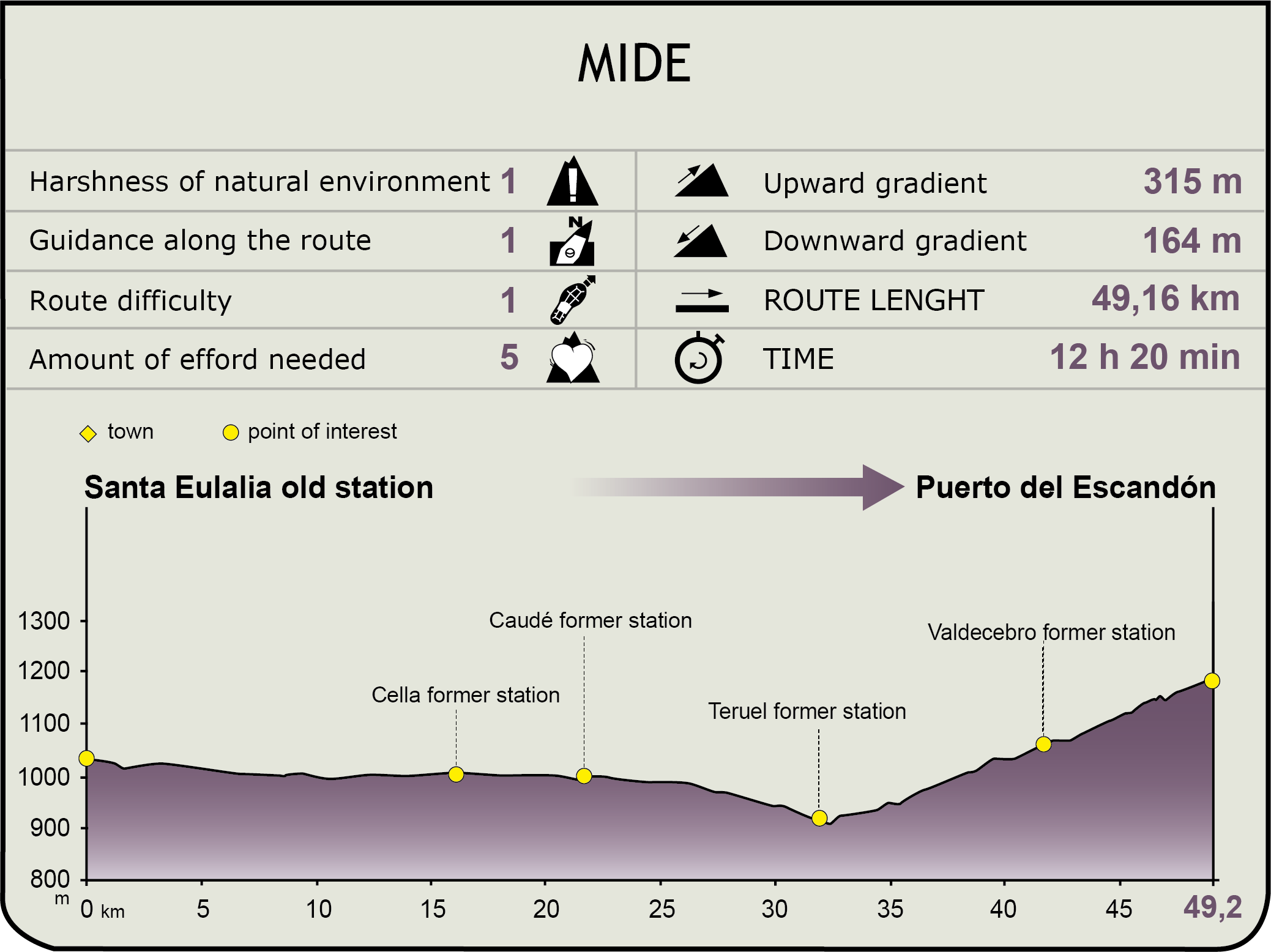
MIDE (Method for the Information of Excursions)
Featured
Further information
Ojos Negros Railway
“Ojos Negros” or Black Eyes was an old iron mine located at the foot of Sierra Menera, in the province of Teruel. A long narrow-track railway line linked the mine to the iron and steel industries of Sagunto, over more than 200 km. Oddly enough, since before its construction, another wide gauge railway line has existed which still runs parallel to the former, outfitted for the transportation of passengers. However, the mining company thought it would be more profitable to build another. After several decades of intense use, it had to ask Renfe if it could use its track to solve the bottle neck caused by its own insufficient method of transport. The line was closed in 1972. Ten years later, the Spanish mining crisis occurred, which caused the final bankruptcy of the mining company and of the metal industry of Sagunto, which had been thriving up until then.
